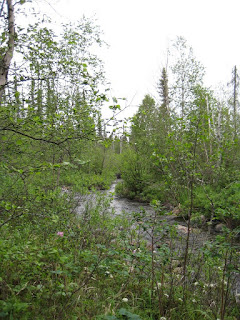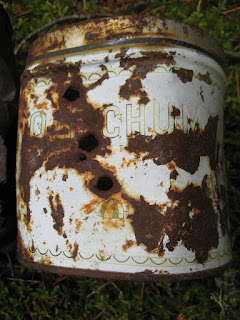The inlet to the lake of Camp 11. I walked along the creek to the next lake. There was evidence of an old portage trail but forest fire and time had made it impassable.
It took three hours to cut a 500 metre trail to the next lake and it rained the whole time. Aie! At one spot there were so many fire-killed down trees that I cut some pieces to bridge over the top, a place where I had to be very careful not to slip on the rain-soaked logs while carrying heavy packs and canoe. The last photo shows a steep cliff that I managed to carry packs up but when it came time to take the canoe I could not manage so had to drag it up before hoisting it over my head to carry it the rest of the way.
Labrador tea plants in bloom. The white flowers are good to eat in a salad.
Bunchberry "flowers". Note the white bunchberry bracts that look like flowers, but are actually modified leaves that surround the true small flower in the centre. It is interesting as the season progresses to see the various plants and insects that appear and mature.
Camp 12, after 11 km of travel, including cutting the 500 metre portage trail. Once I got to the lake above the portage, it took me two hours to find a decent campsite, after stopping five times to investigate various places that were either too steep or too boggy. Meanwhile the rain continued. Aie! But ... better than forest fire. I was able to dig a fire pit in the sandy soil. The next day I erected the canvas tent; the warmth of the stove felt good and it was nice to thoroughly dry my clothes and sleep gear.
When the sun finally appeared I was able to dry all my gear. Most of the packs have the gear inside waterproof bags so it is the outer packs that need drying.
The largest red squirrel midden that I have ever seen. It has been a long time since forest fire scoured this area.
Rainy weather kept up.
A "salt" lick near camp where animals lick the earth to eat minerals they crave.
Cans many years old left by long ago woodsman and used for target practice by someone else.
Orange-red "ochre" earth containing iron oxide which was the material after heating used to create aboriginal rock paintings.
Wild rose in flower. The flower petals are good added to salads. I once added a big handful to a bannock before baking, but it was like eating perfume.




























